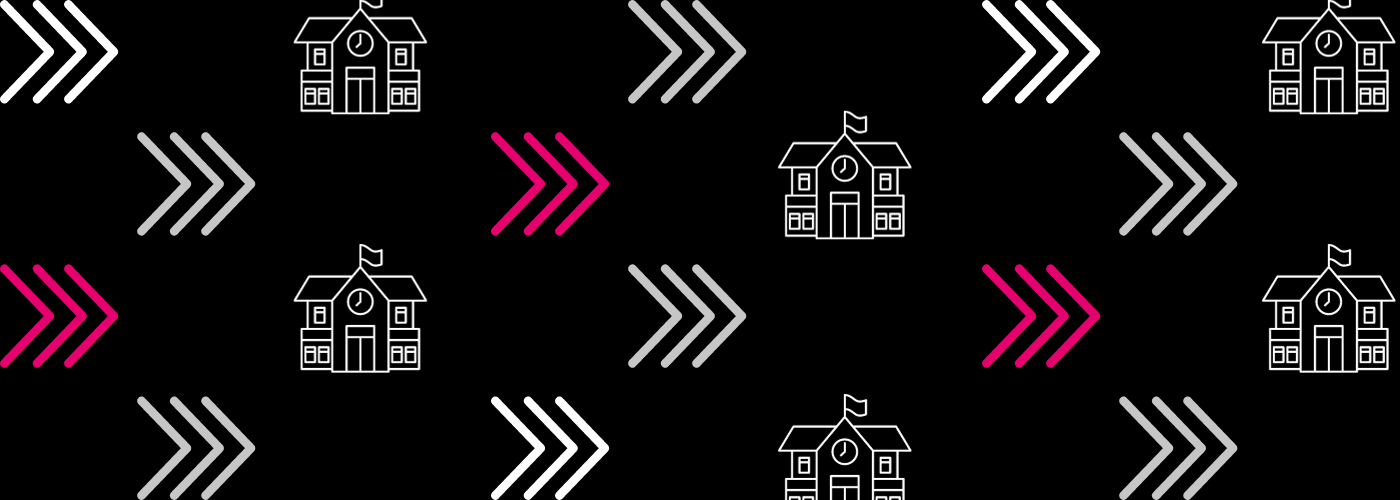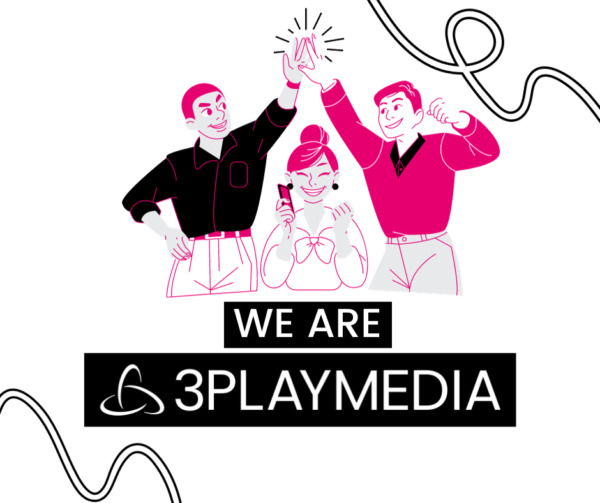Real-Time Captioning in the College Classroom 101
Updated: February 28, 2024
The 3Play Way: Real-Time Captioning in Higher Education [Free Webinar]
As a new school year kicks off, students are stocking up on the traditional academic tools: course books, notebooks, pens, laptops, etc. These items are unquestionably essential to the learning experience for nearly all students. Yet there is another critical learning tool for a significant portion of the student population that often goes overlooked: real-time captions.
Real-time captioning in the college classroom can be equally as important as those course books, notebooks, and laptops–especially for D/deaf and hard of hearing students. That’s because captions help remove access barriers, providing an equitable and inclusive way for students to fully experience lectures and participate in class discussions.
So how does real-time captioning in the college classroom work? In this blog, we’re covering all of the most frequently asked questions about classroom captioning: workflows, captioner qualifications and assignments, how captions are ordered, and more. Get out your writing tools and prepare to take notes, because Real-Time Captioning in the College Classroom 101 is now in session.
How does captioning work in a college classroom?
Real-time captions in a live classroom setting can be delivered to a student through different mechanisms. If the student is present in person, they are usually receiving captions on a second screen, such as a tablet or laptop, using a solution known as Communication Access Realtime Translation, or CART.
For on-demand or remote classes that are not live, closed captions are usually provided in a sidecar file alongside the video recording, which can be toggled on or off by the user.
Who is captioning college classes?

Nowadays, remote CART captioning options and alternatives have become very common, with a remote captioner connecting to the classroom’s audio source, such as a clip-on microphone worn by a professor. The captioner then transcribes the lecture or discussion word-for-word, with live captions populating on a second screen or streaming link to the text.
How do the captioners connect to a class?
We touched on CART solutions and how in the past, a live captioner would sit in a room, transcribing, as captions populate on a larger screen. While this method does still happen for larger events, it’s becoming less common due to advances in technology that allow for greater flexibility with real-time captioning.
Remote CART or similar captioning experiences allow remote live professional captioners to connect to a class’s audio via sources such as phone, RTMP, iCap, Zoom meetings, and more. The lecture is then live captioned, with captions displayed via a second screen or streaming link.
What kinds of qualifications do live professional captioners have?
Real-time captions for college classrooms require a high degree of accuracy to provide an equivalent experience for students requesting accommodations. Live professional captioners should be experienced in providing high-quality, accurate captions and following best practices for real-time captioning.
At 3Play, live professional captioners undergo a rigorous certification process and use 3Play’s innovative proprietary voice writing technology to produce accurate and comprehensive real-time captions.
How accurate are real-time captions for college classrooms?
Live captioning accuracy can be tricky to determine because of a couple of factors at play: Word Error Rate (WER) and Formatted Error Rate (FER). WER is used as the standard measure of transcription accuracy in captions. FER accounts for errors in formatting, sound effects, grammar, and punctuation and is a better representation of the experienced accuracy of captions.
Both of these measurements are crucial to accuracy, yet WER is the most often used by live captioning vendors providing accuracy measurements. Unfortunately, WER on its own is usually not enough to support an accurate and equitable learning experience for students, and that’s where FER comes in. FER accuracy can impact a student’s understanding of the lecture and discussion if punctuation, formatting, and other complexities aren’t captioned correctly.
It’s important for live captions to boast a high accuracy rate that takes into account both WER and FER. 3Play’s innovative combination of humans and technology allows us to consistently obtain high levels of accuracy and quality for college classroom captions.
3Play approaches the context piece of accuracy through a diverse pool of live professional captioners who specialize in an array of topics. These captioners have been certified through our rigorous process and are able to capture the intent of the speaker, ensuring that a class’s proper names, key words, and terminology are captioned correctly.
Additionally, 3Play future-proofs real-time captioning accuracy with robust customization options like custom speaker labels, curated event instructions, and wordlists, which can be uploaded and made available for live captioners to review and reference prior to an event.
The 3Play Way: Real-Time Captioning in Higher Education
How do schools coordinate real-time accommodations for students?
Colleges, universities, and other higher education institutions may handle and coordinate real-time accommodations differently, depending on workflows, budget, and other student needs.
Usually, schools dedicate a position or even a department to handling the accommodation and/or captioning process. These can include CART Supervisors, Real-Time Captioning Coordinators, Student or Disability Services professionals, Access or Disability Resource Center professionals, and more. Student accommodation requests are submitted to these professionals or departments, who then coordinate fulfillment of the accommodation, such as real-time classroom captions.
How do real-time accommodation professionals order and pay for captions?
Higher education professionals usually have a wide range of needs for live accommodations: lectures, meetings, conferences, webinars, and more. These events may be hosted by different departments, campuses, and even individuals. Some universities and colleges have a centralized location and clear policy for student accommodations. Some may be only beginning the process of centralizing, but have some ways to go. Others may use accommodation platforms, like AIM.
This range of needs and policies means ordering and paying for captions can become complex for higher education professionals. They may be the ones doing the actual ordering for all captions, or departments and professors could be tasked with directly carrying out the accommodations with a university’s captioning vendor.
Ordering and billing needs are going to be different at every institution, so vendor agility is very important here. 3Play takes a flexible approach to these aspects by giving professionals exactly what they need to track spending and budget, whether it’s full visibility into how the institution is spending on accessibility services like real-time captioning, or small-scale, single projects with specific purchase orders (P.O.s) attached.
How do real-time accommodation professionals overcome issues with getting captions?
No matter who is directly coordinating real-time accommodations, common issues in the classroom captioning process revolve around captioner coverage, staffing shortages, lack of vendor support, tech issues, and cumbersome workflows. These can make for a poor captioning experience for not only the students, but also the professors, administrators, and other staff trying to create an inclusive learning environment.
Fortunately, there are some key traits to seek in a captioning vendor that will help mitigate inefficient methods for providing real-time accommodations for students.
An ideal real-time captioning accommodation solution should:
- Put students first. At the end of the day, the right vendor should use certified live captioners who can create high-quality, accurate real-time captions that meet a student’s learning needs.
- Offer unparalleled support and visibility to those seeking real-time accommodations for students. A coordinator should be able to receive rapid and attentive support from a captioning vendor.
- Be reliable, yet scalable. A coordinator should have the peace of mind that all courses will be covered by captioners throughout a semester. They should also have confidence that a captioning vendor will be able to continue to support them as their needs grow.
- Provide the ability to seamlessly integrate with popular learning management systems (LMS), video conferencing platforms, and other tools in higher education. A coordinator should have the ability to easily connect with existing higher education tools and take advantage of push-button simplicity so they can focus on what really matters: students’ learning experiences.
How 3Play Supports Students
3Play Media is a trusted provider of accessibility services for colleges and universities. We offer future-proof solutions to transform your university’s accessibility and operational efficiency with a wide range of services, including real-time captioning, closed captioning, audio description, and translation.
Our real-time classroom captioning services are designed for your budget and peace of mind. Here’s how:
We Eliminate Hours of Manual Work for Your Staff
With our user-friendly platform and flexible workflows, your staff can easily manage recurring events, canceled classes, and captioner assignments at the push of a button.
We Are a Reliable Partner with Limitless Scalability
Our marketplace structure ensures your courses will be matched with a qualified professional, regardless of whether you need to support one class or a dozen.
We Offer Compliant Real-Time Captions with 98%+ Accuracy
We offer compliant live solutions that meet all applicable accessibility regulations and provide word-for-word transcription and up to 98%+ measured accuracy.
We Provide Rapid and Attentive Support
Our on-call tech support team will assist you with any issues before and during each scheduled course.
We Have Flexible Billing Options
Our flexible billing options allow you to easily track spending with university or department-based billing.
Learn more about real-time captioning in higher education ⬇️













